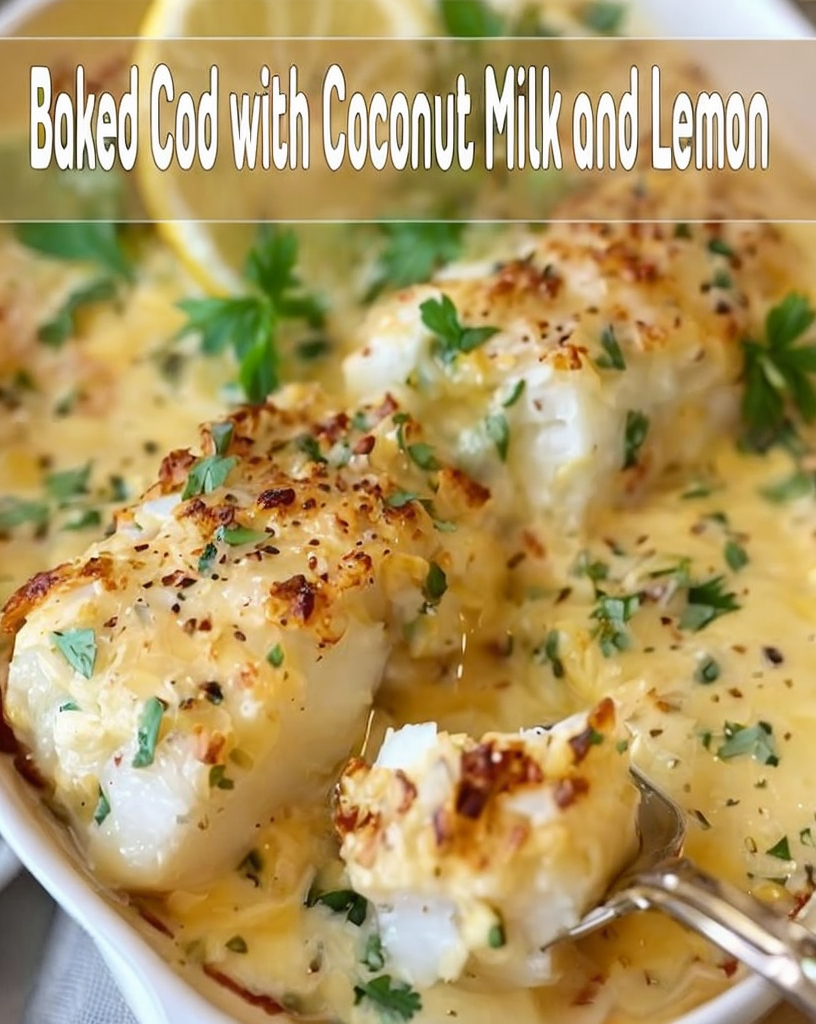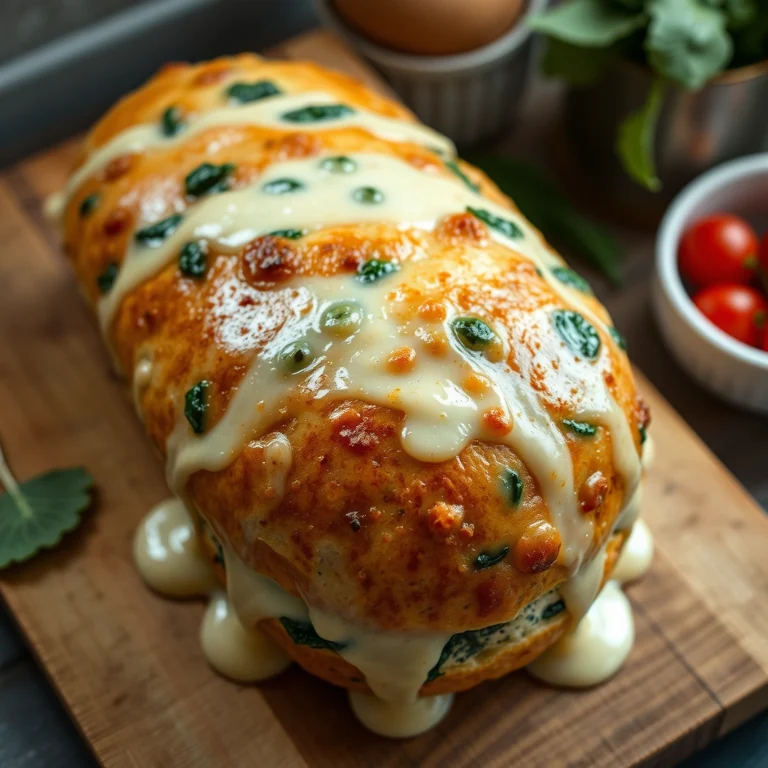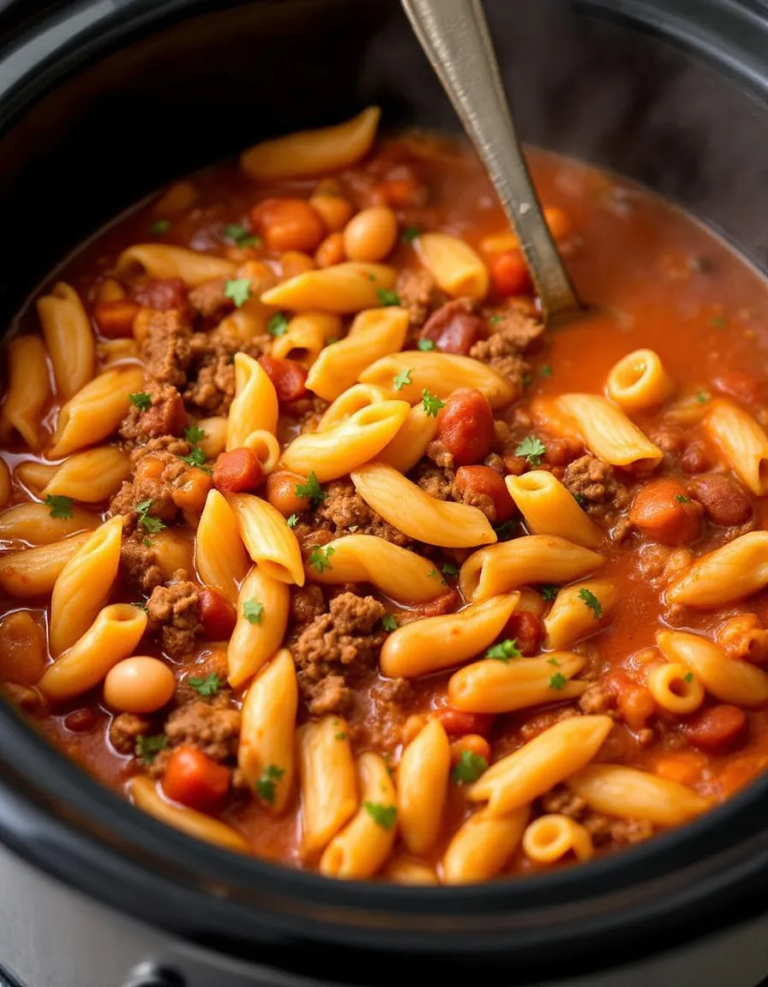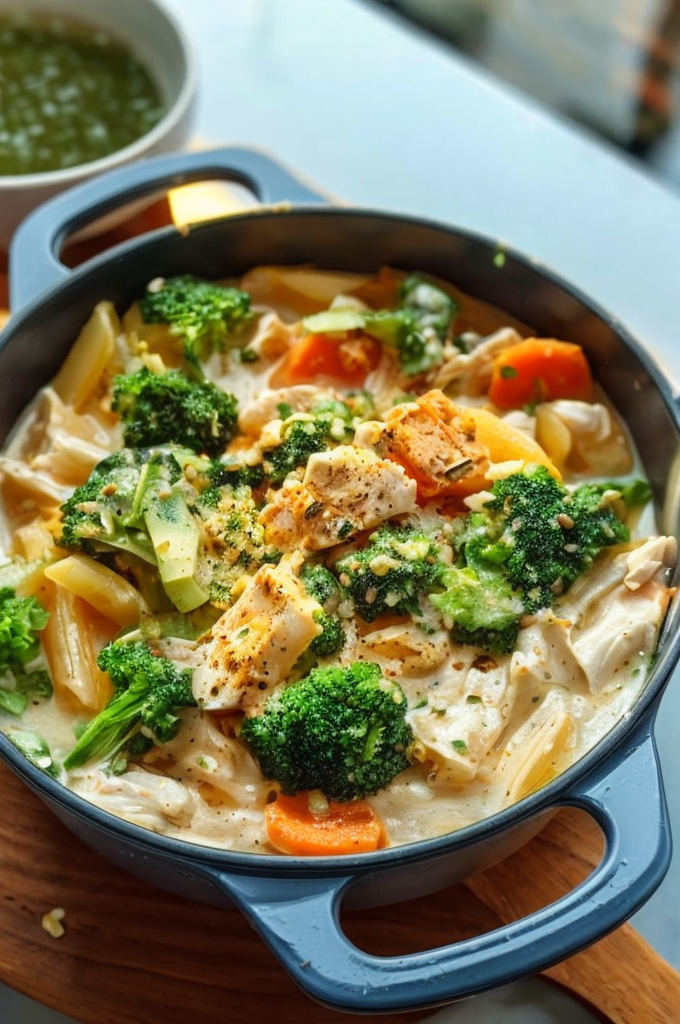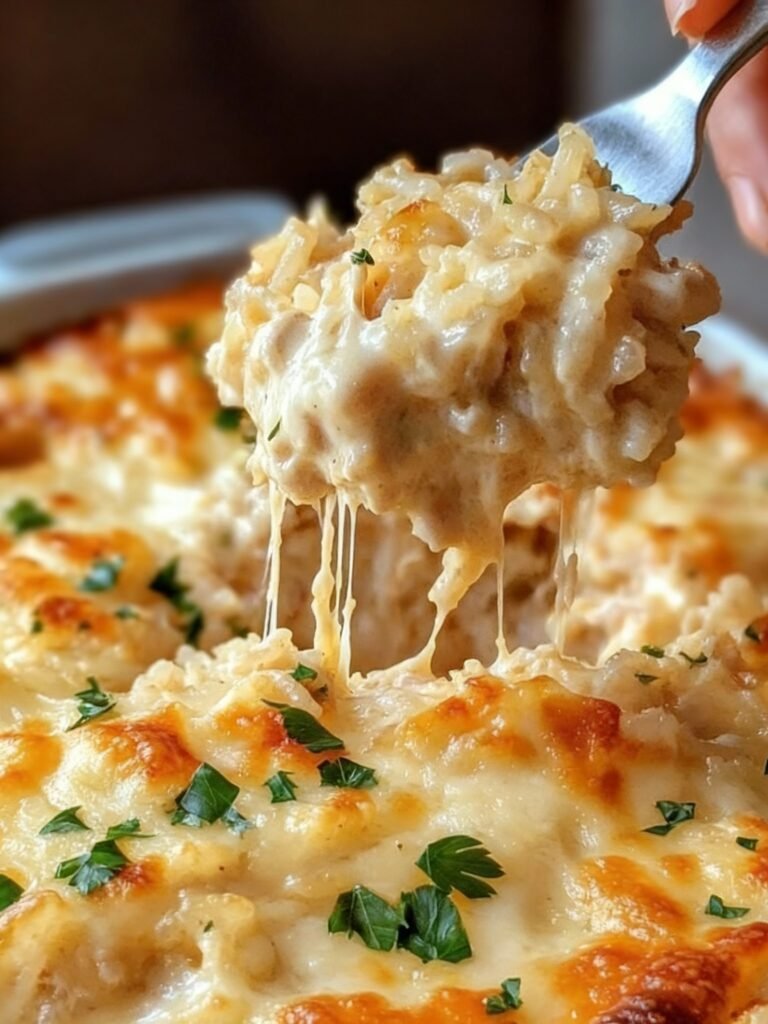Easy Savory Baked Cod in Coconut-Lemon Cream Sauce (Ready in 30 Minutes)
Savory Baked Cod in Coconut-Lemon Cream Sauce: A Delicious Flavor Adventure
Looking for a simple yet outstanding dinner recipe? Our Savory Baked Cod in Coconut-Lemon Cream Sauce is perfect for any occasion. This dish features tender, flaky cod fillets bathed in a rich and tangy coconut-lemon cream sauce. It’s easy to prepare, making it an ideal choice for busy weeknights or elegant weekends.
Combining the smoothness of coconut milk with the zesty brightness of fresh lemon, this baked cod recipe offers the perfect harmony between sweet and tangy flavors. It’s a showcase of how versatile and well-balanced flavors can elevate a humble fish dish into something extraordinary. Whether you’re serving family or entertaining guests, this recipe will leave them delighted and satisfied.
Our savory baked cod boasts a gentle aromatic profile, thanks to a blend of fresh herbs and spices. The subtle coconut aroma complements the natural flavors of the fish, while a hint of lemon zest adds a refreshing note. The result? A delightful taste sensation sure to please even the most discerning palates.
Quick Recipe Highlights
- Flavor Profile: The dish combines the sweetness of coconut with the tanginess of lemon, creating a perfectly balanced profile that enhances the mild flavor of the cod.
- Texture: Expect a beautifully flaky cod fillet, tender enough to cut with a fork, enrobed in a creamy sauce for added moisture and richness.
- Aroma: Bright citrus notes meld with exotic coconut to create an inviting and aromatic experience that fills the kitchen with delightful scents.
- Visual Appeal: A beautifully plated dish with a creamy sauce and a sprinkle of fresh herbs offers an inviting and professional look.
- Skill Level Needed: This recipe is simple enough for beginners yet rewarding for more experienced cooks seeking a quick yet impressive meal.
- Special Equipment: A baking dish and a whisk or blender to ensure a smooth sauce are all you need; no fancy equipment is required.
Recipe Overview
- Difficulty Level: The recipe is easy to follow, making it perfect for cooks of all levels. Basic mixing and baking skills are all you need to replicate this dish with guaranteed success.
- Category: Main Course, Fish, Seafood
- Cuisine: This dish takes inspiration from tropical and coastal cuisines, blending coconut’s creamy richness with the Mediterranean charm of lemon.
- Cost: Budget-friendly, using accessible ingredients like cod, coconut milk, and lemon.
- Season: While it’s a year-round favorite, the bright and tropical flavor is especially popular during spring and summer.
- Occasion: Ideal for family dinners, casual gatherings, and festive celebrations.
Why You’ll Love This Recipe
Love at first bite is guaranteed with this savory baked cod recipe. Its exquisite taste stems from the interplay of a coconut-rich cream sauce accented with fresh lemon. The result is a deliciously moist and tender cod that is sure to titillate your taste buds with every mouthful. This satisfying blend of flavors creates a culinary experience that feels luxurious yet comforting.
Preparing this dish doesn’t require advanced cooking skills or heaps of time. The recipe’s ease and straightforward approach means you can enjoy a gourmet-quality meal even during busy weekdays. With a total cooking time of under an hour, it offers convenience without compromising on delightful taste.
Cod is a fantastic source of lean protein and healthy omega-3 fatty acids, making this dish both nourishing and flavorful. Additionally, coconut milk adds a dose of good fats while keeping the sauce naturally dairy-free. Enjoy this sumptuous meal knowing it supports your dietary goals.
Crafting a sophisticated meal for gatherings can often be challenging, but this recipe shines as a star seafood choice. Impress guests effortlessly with a dish that’s not only eye-catching but also mouthwateringly delicious. Its unique flavor profile is a guaranteed crowd-pleaser.
Economical without skimping on taste, this dish allows you to serve high-quality seafood without breaking the bank. Its ingredients are accessible and affordable, promising a dinner experience that feels like an indulgence but is easy on the wallet. This makes it perfect for both everyday dining and special occasions.
Historical Background and Cultural Significance
The savory combination of cod and coconut finds its roots in various international kitchens. Cod has long been a staple in Northern European diets, celebrated for its mild flavor and adaptability. When global trade routes opened, exotic ingredients like coconut especially from tropical climes started mingling with traditional flavors.
In Mediterranean regions, the citrusy tang of lemon brought a new dimension to many seafood dishes. Over time, recipes like this savory baked cod emerged, marrying tropical flavors with beloved staples into a culinary symphony. This fusion symbolizes cultural interactions fostered by travel and trade.
As recipes evolve, so do the cultures that embrace them. Today’s savory baked cod resonates with chefs and home cooks worldwide, weaving together elements from different cuisines into a modern classic. It represents a melting pot of flavors and techniques passed down through generations.
Regional variations abound; some add a bit of heat with chili peppers, while others incorporate herbs like dill or parsley. Each adaptation though unique, remains true to the core idea of bringing out the best in cod through harmonious flavor pairings. This creative diversity elevates a humble fish dish into an international favorite.
Ingredient Deep Dive
Cod is a versatile, mild-flavored white fish, chiefly harvested in cold North Atlantic and North Pacific waters. It is acclaimed for its nutritional benefits, being a low-fat source of high-quality protein, vitamins, and minerals. Rich in vitamin B12 and omega-3 fatty acids, cod supports good heart health, brain function, and energy production.
When choosing cod, look for fillets with shiny skin and firm, translucent flesh. Press gently to ensure it bounces back, signaling freshness. Storing cod properly requires refrigeration, ideally in an airtight container to avoid cross-contamination with other foods. For added convenience, frozen cod is a viable option, offering a longer shelf life without sacrificing quality.
Lemon elevates this dish with its fresh and zesty notes. Historically, lemons have been cherished both for their preservative qualities and health benefits, including immune support and improved digestion. Selecting plump and heavy lemons with thin, smooth skins ensures maximum juice yield.
Substituting lemon with limes adds complexity with milder tartness, permitting creativity within the recipe while keeping the citrus vibrancy intact. Proper lemon storage involves refrigeration to extend shelf life, preventing drying and maintaining juiciness.
Common Mistakes to Avoid
- Overcooking the cod can result in dry, tough fillets. Keep an eye on the baking time for optimal tenderness.
- Using low-fat coconut milk can diminish the sauce’s richness; full-fat is recommended for creaminess.
- Ignoring the lemon zest when adding lemon juice risks losing zest’s essential aromatic oils.
- Failing to season the cod properly before baking might result in a bland dish.
- Substituting different fish without adjusting cooking times can lead to improper doneness.
- Not whisking the sauce mixture well will lead to a lumpy texture.
- Using canned lemon juice instead of fresh may impart a metallic taste to the sauce.
- Letting the cod sit in the sauce for too long before baking risks over-saturation and mushy texture.
- Skipping the resting period after baking can prevent the flavors from settling and integrating fully.
- Not using fresh herbs for garnish can leave the dish looking and tasting lackluster.
Essential Techniques
A key technique in preparing this recipe is ensuring the cod is evenly baked to achieve the perfect flaky texture. Before baking, the fillets should be patted dry to prevent excess moisture and enable even cooking. This ensures the fish remains moist without becoming waterlogged.
Creating a smooth coconut-lemon cream sauce requires thorough whisking of the coconut milk, lemon juice, zest, and spices. The goal is a cohesive mixture devoid of lumps, unfolding a beautifully creamy sauce enveloping the cod as it bakes. Whisk or blend until reaching a silk-like consistency.
Timing each step is also crucial: start with preheating the oven, allowing it to reach the specified temperature, ensuring an even heat distribution around the cod. This uniformity helps achieve perfect doneness, avoiding over- or under-cooked sections.
Pro Tips for Perfect Savory Baked Cod in Coconut-Lemon Cream Sauce
Pat cod fillets dry before seasoning to ensure even cooking, unlocking the best texture without extra moisture. This step might seem minor but significantly impacts the recipe’s final results.
To intensify the coconut flavor, lightly toast coconut flakes and sprinkle over the dish before serving, adding a delightful layer of texture and taste.
For a sauce that clings beautifully to the cod, ensure the mixture is well emulsified. Whisk the sauce ingredients vigorously until completely smooth – consistency is key.
Introducing a pinch of chili flakes amplifies the dish’s flavor, adding depth and subtle heat while complementing the delicate taste of the cod and lemon-coconut sauce.
Marinating the cod briefly in a bit of the sauce an hour before baking enhances the infusion of flavors. A quick soak allows the cod to start absorbing lemon and coconut undertones.
For optimal freshness, add a spritz of lemon juice and a sprinkle of chopped cilantro or thyme leaves just before serving. This elevates the dish’s zestiness, creating an aromatic finish.
Variations and Adaptations
For a regional twist, replace lemon juice with lime and add a handful of chopped coriander, creating a Latin American-inspired take with bright zest and aromatic flair. The complement of coconut remains harmonious and elevated.
Adjusting ingredients to align with the seasons can enhance flavor; consider adding winter root vegetables like parsnips or carrots during colder months for a comforting variation.
For a low-carb adaptation, serve this savory baked cod atop a bed of mashed cauliflower or zoodles, maintaining rich flavors while aligning with dietary preferences by reducing carbohydrates.
For a textural variation, introduce a crispy topping by combining panko breadcrumbs with shredded coconut. Scatter atop the cod before baking for a delightful crunch complementing the creamy sauce.
Focus on presentation by using vibrant garnishes. Colorful edible flowers or a mix of fresh herbs like parsley, dill, and chervil enhance visual appeal while adding layers of fresh flavor.
Serving and Presentation Guide
Present the savory baked cod with flair, using warm plates to keep the dish temperature consistent. Center the cod fillets atop a streak of sauce with drizzled sauce artfully decorating the perimeter.
Garnishing ideas include a sprinkle of toasted coconut flakes or a side of blanched green beans for added crunch and contrasting freshness. This enhances the dish’s appeal with different textures and flavors.
Traditional accompaniments like steamed rice complement the cod flavor while acting as a neutral backdrop for the vibrant coconut-lemon sauce.
For modern serving suggestions, consider pairing the dish with a crisp, light salad featuring arugula and cherry tomatoes dressed simply with olive oil, lemon, and salt.
Temperature considerations are crucial; serve the dish fresh from the oven while allowing a brief resting period for the flavors to meld. This prevents any thermal shocks, ensuring a seamless tasting experience.
Portion control tip: serve one cod fillet per person with roughly half a cup of sauce, ensuring a balanced plate presentation that delights without overwhelming.
Wine and Beverage Pairing
A crisp Sauvignon Blanc pairs wonderfully with the savory baked cod, heightened by its citrus notes complementing the dish’s lemon undertones. The wine’s acidity cuts through the coconut cream, refreshing the palate.
For non-alcoholic alternatives, choose a lemon-infused sparkling water or minty iced tea, providing a clean, complementary flavor profile that marries well with the dish’s aromatic elements.
If you’re inclined toward coffee or tea pairings, consider a light, citrus-infused white tea; its mild flavor profile won’t overpower the delicate cod.
Beverage temperature can affect the tasting experience: serve drinks chilled or at room temperature, ensuring they enhance rather than overwhelm the meal’s flavors.
If looking for more innovative ideas, an iced coconut water with a splash of lime embodies the meal’s flavors, serving as an intriguing and tropical counterpart.
Storage and Shelf Life
Storing leftover savory baked cod properly preserves its freshness. Transfer the dish to an airtight container, separating the cod fillets from the sauce to prevent sogginess, and refrigerate.
Ensure the storage refrigerator maintains a temperature of 40°F (4°C) or below to prevent spoilage while extending the cod and sauce’s shelf life for up to 2 days.
Choose glass or BPA-free plastic containers that provide a tight seal, preventing cross-flavors from affecting the dish within the refrigerator.
Watch for spoilage signs, such as off-odors or changes in texture, indicating reduced freshness. If detected, it’s safer to discard rather than risk consuming spoiled seafood.
For reheating, gently warm the cod in a preheated oven at 300°F (150°C) for 15 minutes, ensuring even heating without overcooking. Apply a light drizzle of sauce to maintain moisture.
Freezing is possible but may affect texture. If needed, store the sauce and cod separately in airtight containers and freeze for up to 1 month. Thaw thoroughly in the refrigerator before reheating.
Make Ahead Strategies
Planning a prep timeline ensures flawless execution; consider making the sauce a day in advance. Allow flavors to meld overnight, heightening its richness.
Store prepared sauce in the refrigerator, sealed in a jar or container, to maintain freshness and ease the cooking process on serving day. Label the container for accurate identification.
Making components ahead boosts efficiency but may affect freshness. Prioritize freshness over convenience, balancing elements made in advance with freshly baked fish.
When ready to bake, assemble the dish quickly: pour a pre-chilled sauce over the cod and bake immediately to marry fresh flavors with make-ahead convenience.
For enhancing quality, add pre-cut lemon slices immediately before serving, refreshing the dish with naturally bright flavors that have diminished during storage.
Reheating guideline: gently warm the sauce separately to maintain a smooth consistency, reducing risk of overcooking the fish when reheated together.
Scaling Instructions
When halving the recipe, carefully adjust ingredient quantities accordingly. Ingredients like spices and herbs can be adapted to taste, but ensure even distribution.
Doubling or tripling the recipe requires proportional adjustments to ingredient amounts and cooking time; extend bake time slightly with higher quantities to achieve uniform doneness.
Consider equipment adjustments; larger cooking batches require proper pan sizes to avoid overcrowding. Choose baking dishes offering ample room for cod fillets and sauce to cook evenly.
Timing modifications, such as increasing baking time, derive from thicker sauce layers or increased fish volume. Monitor closely throughout baking to adjust times if necessary.
Storage considerations for larger batches mean preparing ample container space and using multiple containers if needed. Ensure each container is sealed properly for freshness.
Nutritional Deep Dive
Cod’s macro breakdown highlights its high protein content with minimal fat, lending lean nutritional value to the meal. This supports muscle maintenance and overall growth while reducing dietary fat intake.
From a micronutrient perspective, cod offers Vitamin B12, crucial for nerve health, and selenium, a key antioxidant. Meanwhile, coconut and lemon infusions contribute vitamins C and E, reinforcing immunity.
This recipe aligns with health-benefiting goals, amalgamating all nutrient-dense ingredients into a dish encompassing macronutrients, healthy fats, and vital vitamins.
Considerations include portion control to avoid overconsumption despite high nutritional value. With the richness of coconut, mindful satisfaction is encouraged without leaving an overwhelming feeling after dining.
The balanced portion analysis ensures that each serving provides a satisfying, sufficing meal without dietary overload, optimizing nutrient intake across meals.
Weight management tips advise pairing the baked cod with a light side salad and controlled carb intake to support a balanced nutritional profile aligned with dietary aims.
Dietary Adaptations
For gluten-free adaptation, ensure all spices and ingredients used are certified gluten-free, avoiding cross-contamination with gluten products.
Dairy-free adaptation is inherent in the recipe, as it predominantly utilizes coconut milk for creaminess, naturally aligning with lactose-intolerant dietary needs.
For a vegan version, replace cod with firm tofu or tender jackfruit chunks, mimicking texture while maintaining the meal’s core features. Consider adjusting sauce seasoning for balance.
Low-carb adaptation utilizes accompanying sides like cauliflower rice, retaining the main dish’s flavors while aligning with carbohydrate-restrictive diets.
The keto lifestyle fits seamlessly as the meal naturally emphasizes healthy fats from coconut milk, complementing essential proteins present in cod. Check individual seasoning choices for low-carb compatibility.
Paleo adaptation suits by adhering to natural ingredient selections fitting within Paleo-compliant guidelines, while respecting the recipe’s foundational elements.
A low-FODMAP option eliminates high-FODMAP ingredients like garlic and onions, preserving palette satisfaction while maintaining digestive compatibility with the diet plan.
The Recipe
Savory Baked Cod in Coconut-Lemon Cream Sauce
Serves: 4
Prep Time: 15 mins
Cook Time: 25 mins
Total Time: 40 mins
Kitchen Equipment Needed
- Baking dish
- Whisk
- Measuring cups and spoons
- Small saucepan
- Oven
Ingredients
- 4 cod fillets
- 1 can (14 oz) full-fat coconut milk
- Juice and zest of 2 lemons
- 2 cloves garlic, minced
- 1 tablespoon olive oil
- Salt and pepper to taste
- Fresh thyme sprigs for garnish
Directions
- Preheat your oven to 375°F (190°C).
- Season the cod fillets with salt and pepper on both sides.
- In a saucepan, combine coconut milk, lemon juice and zest, minced garlic, and olive oil. Simmer gently for 3-4 minutes, whisking until smooth.
- Place the cod fillets in a baking dish. Pour the coconut-lemon cream sauce over the fillets, ensuring they’re well covered.
- Bake for 20-25 minutes, or until the cod is opaque and flakes easily with a fork.
- Garnish with fresh thyme sprigs before serving.
- Serve immediately with a side of your choice.
Recipe Notes
- For added color, sprinkle a pinch of paprika on top before baking.
- If you prefer a thicker sauce, reduce the coconut milk by simmering longer before pouring over the fish.
- Using fresh cod is ideal but a frozen option works well if thawed thoroughly before cooking.
Troubleshooting Guide
Texture issues often arise from improper baking times, leading to dryness. Monitor baking to avoid overcooking for a flaky, moist outcome.
If flavor balance leans too acidic, add a sweetness like honey or a bit more coconut milk to mellow the dish without altering core flavors.
Temperature problems stem from uneven oven heat. Preheating and using a reliable internal thermometer ensures optimal cod cooking.
Equipment challenges may involve mismatched baking dish sizes. Ensure the fish fillets lay in a single layer for even baking in a properly sized dish.
Ingredient substitutions present obstacles when improperly matched; maintain a balance with appropriate substitutes to retain the dish’s essence.
Timing concerns require attention; adhere to recommended rest periods after baking to help the flavors settle and integrate fully.
Recipe Success Stories
Community feedback often highlights the dish’s simplicity juxtaposed with mouthwatering, complex flavors—many appreciating its elegance for entertaining guests.
Variation successes emphasize enjoyable alternatives like adding a handful of capers for a briny touch, welcoming innovation while retaining original spirit.
Adaptation stories showcase the creative outcomes of those who substituted tofu, enjoying a vegan twist without compromising overall satisfaction.
Reader suggestions frequently inspire with ingredient additions like scallions for heightened aroma or an extra dose of garlic for robust depth.
Photography tips advise capturing the dish’s fresh garnishes and vibrant colors with natural lighting, allowing each detail to shine in visual representations.
Frequently Asked Questions
Full-fat canned coconut milk offers the creamiest consistency and richest flavor, enhancing the dish’s overall depth without overshadowing the cod.
Can I use frozen cod for this recipe?
Yes, frozen cod works as long as it’s thoroughly thawed before use to ensure even cooking and maintain the dish’s quality.
Is it okay to use bottled lemon juice?
Use fresh lemon juice whenever possible for maximum flavor and aroma, avoiding the often metallic taste associated with bottled varieties.
How can I reduce the sauce’s richness?
Consider blending equal portions of coconut milk and vegetable broth for a lighter sauce while maintaining essential flavors and creaminess.
What side dishes complement this recipe?
Steamed jasmine rice or a fresh garden salad provide great contrasts, balancing the dish’s richness without overpowering the cod’s delicate taste.
Can I substitute the cod with another fish?
Yes, opt for mild-flavored white fish like haddock or tilapia as substitutes, ensuring a similar cook time for comparable results.
How can I tell when the cod is fully cooked?
Cooked cod will appear opaque and flake easily with a fork. If unsure, use a meat thermometer; fish is done when internal temperatures reach 145°F (63°C).
Does the recipe freeze well?
Freeze separately for optimal texture preservation; thaw in the fridge before reheating gently to prevent any adverse texture changes.
Can I reduce sodium content?
Control the amount of salt added, and choose low-sodium and fresh ingredients when possible to lower overall sodium levels in the dish.
Will the acidity of the lemon affect the cooking process?
No, lemon balances acidity and coconut sweetness without interrupting cooking. Incorporating lemon zest adds complexity without affecting texture.
Additional Resources
Explore related recipes like Coconut Curry Shrimp or Lemon Herb Roasted Vegetables for culinary inspiration that complements the savory baked cod’s flavor profile.
Technique guides on emulsifying sauces and baking techniques can deepen understanding while mastering smooth sauce preparations.
Ingredient information delves into the nutritional aspects of coconut and cod, offering a comprehensive outlook on their benefits in supporting a healthy diet.
Equipment recommendations include essential tools like an oven thermometer and proper baking dishes, ensuring best results for this and other recipes.
Seasonal variations inspire explorations of new ingredient pairings that highlight the dish’s innate adaptability, encouraging further experimentation.
Join the Conversation
Engage with others by sharing your own attempts at this recipe on social media platforms, encouraging community feedback and dialogue around unique adaptations.
Photography tips focus on capturing the dishes’ fresh garnishes and vibrant colors, using natural lighting to allow each element to shine and evoke appetizing visuals.
Encourage those who recreate the recipe to leave comments and reviews, sharing their experiences and building a dialogue around personal success stories.
Engage with the community by posing questions or inviting alternative suggestions for novel variations, fostering an interactive exchange of ideas.
Consider discussing plating techniques and presentation ideas that make the meal Instagram-worthy, showcasing its delightful appearance alongside its delicious flavors.

